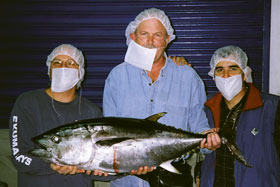  |
| HOME | THIS ISSUE | CALENDAR | GRANTS | BACK ISSUES | < BACK | NEXT > |
Research team studying tuna aquaculture in Mexicoby Peg Van Patten& Monica Allard Cox - March 19, 2007 | ||||
| As tuna ranching expands rapidly along Mexico’s Baja California peninsula on the Pacific coast, just below the U.S./Mexico border, a team of researchers from the United States and Mexico is undertaking a study of the industry. The practice began in 1996 with just a couple of operations, but the favorable temperate climate and a lack of quota regulations led to rapid growth, according to the World Aquaculture Association. Tuna aquaculture has not caught on in the U.S. because of regulatory restraints and conflicting uses of the coast. As both production and demand increase, environmental and conservation concerns are growing, too. Seeking best practices The study is funded by the Packard Foundation. The researchers are examining aquaculture practices and networks, and will evaluate governance and social issues associated with “capture-based” tuna ranching. They hope to determine best practices and make recommendations regarding the methods needed to develop successful captive reproduction, feeds, and non-polluting systems for tuna farming. Currently, fishing boats capture two-year-old tuna in nets as they swim along the coast offshore, tow them slowly toward the shore and enclose them in circular pens in inshore bays, then fatten them up with small fish such as sardines for several months before selling them. “Mexican tuna operations are often incorrectly called ‘farms’ but should more appropriately be termed ‘ranches’,” says Yarish, because they use wild-caught fish for both stocks and feeds. A true “farm” would be one in which fish are raised from egg to adult stages in captivity, likely using a closed-system aquaculture process, he says. The fish would not be killed for market until an order was received, so they would stay fresh and could readily be shipped, for example, from Baja to Los Angeles to Tokyo. The species currently marketed include predominantly the Pacific Bluefin tuna, Thunnus thynnus orientalis, which is prized by gourmets, but also smaller quantities of yellowfin and bigeye tuna.
The fattening process in the pens increases the oil content. “That means it is higher in the Omega-3 fatty acids that are so beneficial to health, and also has great flavor and texture, with an attractive sheen,” says Nancy Balcom, Connecticut Sea Grant extension leader. Most of the highest quality tuna, from more than eight permitted operations, currently goes to Japan. The portion sold in the U.S. mostly goes to upscale restaurants on the west coast, but more may become available as the market grows. The highest quality tuna is the most desirable for use in sushi, sashimi, and other food products. Properly handled meat from the belly, called toro, is said to be especially tender, and is pink to rosy wine-red in color. It fetches the highest price, up to $45 per pound at the Tsukiji market in Japan. Generally the fish weigh at least 160 pounds when sold, but they can be much larger. Sustainable industry “The Japanese demand for bluefin tuna is at an all-time high, and tuna is the second-most popular seafood in the United States. Tuna capture fisheries have decimated Atlantic stocks, and, while tuna fisheries in the Pacific are in much better shape, the trends toward increased fishing of Pacific tuna stocks are alarming,” says Costa-Pierce. “It is urgent that we develop an internationally credible scientific basis for sustainable tuna farming,” he adds, “that could decrease pressure on tuna stocks, while also being environmentally and socially sustainable. |
| ADVANCE HOME UCONN HOME |

